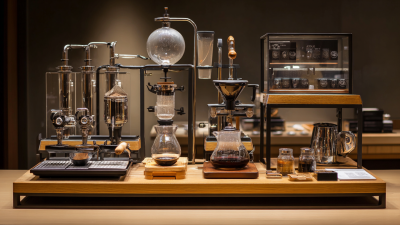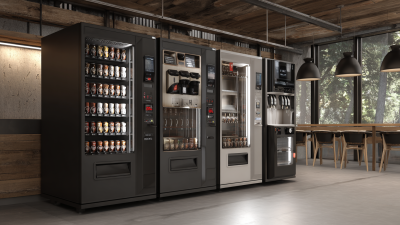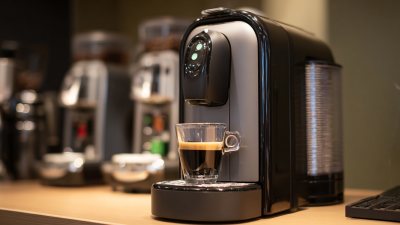
Blog
7 Unbeatable Strategies for Sourcing Coffee Equipment Worldwide
As the global coffee market continues to expand, projected to reach over $200 billion by 2025 according to industry reports, the sourcing of high-quality coffee equipment has become a pivotal factor for businesses striving to stand out in a competitive landscape. The rise in specialty coffee consumption, alongside a growing appreciation for artisanal brewing methods, underscores the need for innovative and durable coffee equipment that meets the evolving demands of consumers. A recent study indicated that 60% of coffee drinkers are willing to pay more for premium products, making it essential for suppliers to invest in top-notch coffee equipment that can enhance brewing efficiency and flavor profiles. By leveraging strategic sourcing practices, businesses can secure the best equipment from around the globe, ensuring not only quality but also sustainability and cost-effectiveness in their operations.

The Importance of Global Sourcing for Quality Coffee Equipment
In today’s competitive coffee industry, the importance of global sourcing for high-quality coffee equipment cannot be overstated. When coffee businesses look beyond their local markets, they discover a vast array of innovative technologies and products that can elevate their offerings. Global sourcing allows companies to tap into specialized equipment made by artisans and manufacturers in regions known for their coffee culture. By sourcing equipment from places like Italy for espresso machines or Japan for pour-over devices, businesses can enhance their product quality and appeal to a discerning customer base.
Furthermore, global sourcing ensures access to the latest advancements and trends in coffee technology. Equipment sourced from different parts of the world may feature innovative designs or superior materials that are not available domestically. This not only elevates the overall coffee experience but also provides an edge in a saturated market. Ultimately, global sourcing facilitates a continuous exchange of ideas and practices that fosters innovation, allowing coffee businesses to remain at the forefront of the industry while delivering unparalleled quality to their customers.
7 Unbeatable Strategies for Sourcing Coffee Equipment Worldwide
| Strategy | Description | Benefits | Challenges |
|---|---|---|---|
| Research and Networking | Build a network of suppliers through industry events, online forums, and trade shows. | Access to diverse suppliers and insights into market trends. | Time-consuming to establish connections. |
| Quality Control Inspections | Implement regular inspections during and after production runs. | Ensures high-quality standards are met. | Increased costs and logistics management. |
| Leverage Technology | Utilize online platforms for sourcing and communications. | Streamlined sourcing processes and wider reach. | Dependency on technology and internet connectivity. |
| Local Partnerships | Form strategic alliances with local suppliers. | Enhanced adaptability to market needs and reduced shipping costs. | Potential limited supplier options. |
| Sustainability Practices | Source from suppliers adhering to sustainable practices. | Improves brand image and attracts eco-conscious consumers. | Higher costs and limited options. |
| Market Research | Conduct thorough market research to identify trends and demands. | Aligns sourcing strategies with market needs. | Requires skilled resources and data analysis. |
| Regulatory Compliance | Ensure all sourced products meet local and international regulations. | Reduces legal risks and enhances product credibility. | Complexity of regulations across different regions. |
Leveraging Technology for Efficient Coffee Equipment Procurement
 The coffee equipment procurement landscape has dramatically evolved with advancements in technology, enabling businesses to source high-quality products from around the globe. By leveraging digital platforms and tools, coffee entrepreneurs can streamline their buying process and access a broader range of suppliers. This transition to online sourcing not only enhances efficiency but also fosters greater transparency in lead times, pricing, and product specifications. Utilizing data analytics, businesses can make informed decisions based on real-time market trends and supplier performance.
The coffee equipment procurement landscape has dramatically evolved with advancements in technology, enabling businesses to source high-quality products from around the globe. By leveraging digital platforms and tools, coffee entrepreneurs can streamline their buying process and access a broader range of suppliers. This transition to online sourcing not only enhances efficiency but also fosters greater transparency in lead times, pricing, and product specifications. Utilizing data analytics, businesses can make informed decisions based on real-time market trends and supplier performance.
Moreover, integrating artificial intelligence and machine learning into procurement practices can significantly improve supplier selection and inventory management. Automated systems can predict equipment needs based on consumption patterns and sales forecasts, reducing the risk of overstocking or stockouts. Additionally, virtual trade shows and platforms allow coffee businesses to connect with manufacturers worldwide, breaking geographical barriers that previously limited sourcing options. Embracing such technological innovations, companies not only optimize their supply chains but also secure better deals, ultimately contributing to a more sustainable and competitive coffee industry.
Identifying Reliable Suppliers: Key Metrics and Considerations
When sourcing coffee equipment worldwide, identifying reliable suppliers is crucial for ensuring quality and sustainability. One key metric to consider is the supplier's certification and compliance with industry standards. According to a report by the Specialty Coffee Association, more than 70% of coffee consumers prioritize sustainability. Therefore, selecting suppliers who adhere to certifications such as Fair Trade and Rainforest Alliance can enhance your brand’s credibility and appeal to ethically-minded consumers.

Another important consideration is the supplier's production capacity and lead times. Industry data indicates that companies with streamlined supply chains can reduce delivery times by up to 30%, which is essential in the fast-paced coffee market. Additionally, evaluating suppliers based on customer reviews and their responsiveness to inquiries can provide insights into their reliability. A recent survey revealed that 85% of businesses reported that their suppliers' communication influenced their satisfaction and continued partnership. By focusing on these key metrics, companies can establish strong relationships with dependable suppliers, ultimately leading to a robust and efficient sourcing strategy.
Maximizing Cost Efficiency Through Strategic Sourcing Partnerships
Strategic sourcing partnerships can significantly enhance cost efficiency when acquiring coffee equipment globally.
By collaborating with reliable suppliers from different regions, businesses can tap into local markets and reduce shipping costs. Engaging with manufacturers directly or forming alliances with local distributors not only lowers expenses but also offers insights into quality and innovation. This localized approach helps importers navigate fluctuating market trends and source cutting-edge equipment that meets evolving consumer demands.
Moreover, establishing long-term relationships with suppliers fosters negotiation power, enabling coffee businesses to secure favorable pricing and terms. This collaboration can lead to shared market intelligence, which is invaluable for anticipating future sourcing needs and maintaining competitiveness. Companies should actively assess potential partners for their reliability and capacity to deliver, ensuring alignment on sustainability practices and ethical sourcing. By prioritizing these strategic alliances, coffee businesses can optimize their supply chain, ensuring both cost efficiency and access to superior equipment.
Sustainability in Sourcing: The Growing Demand for Eco-Friendly Equipment
The coffee industry is experiencing a significant shift towards sustainability, with an increasing demand for eco-friendly equipment from roasters and retailers alike. A report by the Specialty Coffee Association indicates that 63% of consumers now prefer brands that demonstrate environmental responsibility. As businesses revamp their sourcing strategies, it's crucial to focus on equipment that minimizes environmental impact while maintaining efficiency and quality.
Tip: When sourcing coffee equipment, look for suppliers that use sustainable materials and practices. For example, consider companies that provide durable machinery with energy-efficient features, which can reduce long-term operational costs while aligning with green initiatives.
Moreover, the trend extends beyond sourcing; consumer preferences are evolving. According to a survey by the International Coffee Organization, 75% of coffee drinkers are willing to pay more for sustainably sourced products. This data highlights the importance of investing in eco-friendly equipment, as it not only reflects business values but also enhances customer loyalty.
Tip: Collaborate with manufacturers that demonstrate a commitment to sustainability, such as those producing equipment from recycled materials or those invested in carbon offset programs. This strategic partnership can improve your brand image and appeal to a growing segment of environmentally-conscious consumers.
Related Posts
-

Exploring Innovative Alternatives in Best Brew Coffee Equipment for Global Buyers
-

Unlocking the Advantages of Optimal Brew Coffee Equipment for Your Daily Ritual
-

15 Best Coffee Bean Machines You Can't Live Without in 2023
-

Future Innovations in Best Single Coffee Machines Shaping the Coffee Industry by 2025
-

Innovative Solutions for Maximizing Profits with Best Coffee Vending Machines
-

7 Amazing Benefits of Using Single Cup Coffee Machines
